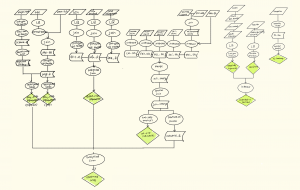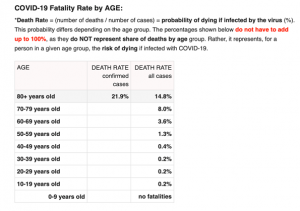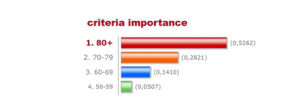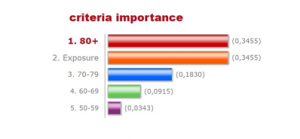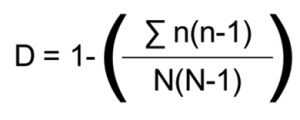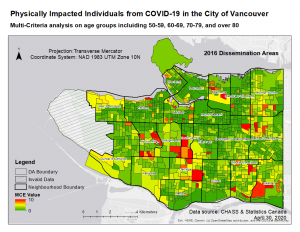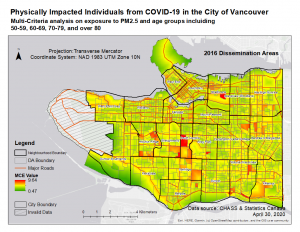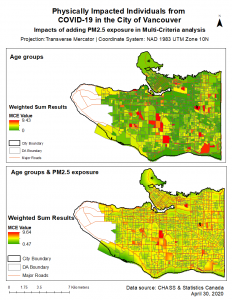Identified as a pandemic, COVID-19 has grown to be a global issue affecting countries worldwide. Within British Columbia, Canada, a state of emergency had been declared, allowing only essential businesses to keep running and restrictions on group gatherings, travel and many more. The aim of this paper is to conduct an exploratory analysis on the impacts the novel coronavirus has in Vancouver through a health and economic standpoint as well as an exploration on vulnerable and resilient occupations. Five main sections to this analysis were done. The first was to identify dissemination areas (DA) more physically at-risk, including seniors and those exposed to high PM2.5 concentrations. Location quotient (LQ) analysis and a weighted multi-criteria evaluation (MCE) model based on mortality rate was done. The second was to identify DAs more economically at-risk from an individual’s perspective. This layer included those whose occupations were from the service and sales industry, those who are 65 years old and over or spend 30% of their income or more on shelter costs. An LQ and MCE analysis was done on this layer as well. The third layer examined businesses that are most likely closed or losing business, including restaurants, bars, etc using a heatmap. The final map was a MCE which combined the above 3 layers to identify regions that are negatively affected in a health and economic standpoint. Additional analysis was done including a diversity index and LQ heatmaps for occupations negatively impacted or resilient. Results from this study showcased a final MCE detailing multiple viewpoints to identify vulnerable communities. Overlapping data shows that dissemination areas near Mount-Pleasant, South Cambie and Downtown communities may be focus areas for COVID-19 policy response efforts.
Introduction
COVID-19 is a virus that causes diseases ranging from common colds to severe illnesses including Severe Acute Respiratory Syndrome (SARS) (CDC, 2020). Identified as a pandemic, it has become a global issue with 228,051 reported deaths as of May 1, 2020 (National Geographic, 2020). Within British Columbia, Canada alone, there have been 2087 cases and 109 deaths as of April 29, 2020 (Bharti, B., 2020). Since BC had declared a state of emergency, only essential businesses were able to keep running. Multiple restrictions have been put into place, including physical distancing, travel restrictions and multiple business and school closures (CDC, 2020). Not only has there been significant health-related risks associated with this virus, but also many economic impacts on both the individual and commercial level.
Although there have been reports of great financial distress among small companies and individuals who have lost their job due to COVID-19, understanding its impacts from a geospatial perspective can provide insight on spatial patterns. Due to the novel nature of this virus, and the difficulty in acquiring information on how it can spread and to which communities, this paper aims to explore the impact of COVID-10 in Vancouver through a multifaceted lens. The main goals include identifying areas that are most at risk in not only a health perspective but also from an economic one for both individuals and businesses. Additionally, an exploration on vulnerable occupations will be included, as well as resilient communities. The final map aims to identify the main areas negatively affected by accounting for economic and health impacts.
Methods
This study examines the COVID-19 impacts in 4 ways in order to identify areas in Vancouver that are: physically at-risk, individually economically at-risk and business-areas at-risk. All 3 of these layers were then combined to create a summarized multi-criteria evaluation model for the COVID-19 impacts in all three of these areas. An additional analysis involving occupational data was done as well in order to identify areas that had high resilience as well as high negative impacts on employment.
Below is a flow chart on the methods used for each layer.
Methods: Physically at-risk age only
The first step we wanted to take in our research is to identify those who were the most physically vulnerable to COVID-19. In this project, we considered age and exposure to air pollutants as the major factors that determine the at-risk population in terms of physical health. The population was divided into four groups: 50-59 years old, 60-69 years old, 70-79 years old and over 80 years old. As for air pollutants, we examined residents’ exposure to fine particulate matter (PM2.5).
To make an integrated analysis on above factors, we conducted Multi-Criteria Evaluation (MCE). CHASS provided the 2016 census data and a shapefile of the transportation network was downloaded from Statistics Canada.
MCE for Age Groups
Location quotients (LQ) were calculated for each factor to identify dissemination areas (DAs) with higher levels of at-risk groups. LQ is the ratio of the percentage of a given age group in a DA to the percentage of that age group in the whole city of Vancouver. For instance, in DA59150701, there are 530 people over the age of 50, of whom 30 are over the age of 80. In Vancouver, there are 633,125 people over the age of 50, of whom 27,525 are over the age of 80. Therefore, the LQ value of people over 80 years old for this DA calculated is:
LQ = (30/530)/(27525/633125) = 1.30.
If the LQ is greater than 1, the DA has a disproportionately larger share of a particular group of age. We would therefore look at these LQs and normalize those with values of 1 and below to 0. The normalized LQ data were joined to the DA layer and then converted into raster layers for each age group.
Taking into account the different responses to COVID-19 in different age groups, we weighted it according to the respective mortality rates provided by New York City Health as of April 14 (Figure below). The death rate shows the risk of dying if infected with COVID-19, for a person in a given age group. Weighted importance of each of the four factors was chosen using the analytic hierarchy process (AHP). After comparison of each factor, the weights are as in Figure 2. The final weighted map was then created using Weighted Sum.
The final weighted map was then created using Weighted Sum.
* There was uncertainty involved in this step. The 80+ age group is 11 times more important than the 50-59 age group, but we set the importance index at 9 because it is the maximum on the AHP calculator.
Methods: Physically at-risk age and PM2.5 exposure
MCE for Age Groups and PM2.5 Exposure
Studies have shown that people with COVID-19 who live in regions with higher levels of air pollution, especially PM2.5, are more likely to die from the disease (Wu et al., 2020). Therefore, we considered long-term exposure to high levels of PM2.5 as another factor in the MCE analysis.
We first created a finer grained surface to show different risk levels with exposure to PM2.5 on a local scale. The major transportation routes included highways and major bus routes were selected from the transportation network data, this layer was then converted into a raster surface.
By using this raster surface, we created a Euclidean Distance surface. Raster calculator was used to normalize the distance surface, and the expression we used was as follow:
( (max value of distance surface – [distance surface] ) / max value of distance surface ) ) *10
The output surface represented the residents’ exposure to PM2.5. It ranged from 0 to 10 and 10 was the closest value to the main road.
To determine the weight of this factor, we referred to the research from Harvard University (Wu et al., 2020), which tells for every 1um/m3 increase in PM2.5 concentration, covid19 mortality increased by 15% (95% confidence interval). Official data shows that from 2009 to 2014, the average concentration of PM2.5 increased by about 1 um/m3 (Government of Canada, 2016) .Therefore, we assume that at least 15% of the deaths of covid19 in vancouver are caused by this increase. The weight of each factor was then recalculated, and the result is shown as below. The final weighted map was also created using Weighted Sum.
* There was uncertainty involved in this step. We assumed that all the roads are weighted equally. A more nuanced representation can be done by using different weights for the different types of roads.
Methods: Individuals economically at-risk
The second step we wanted to examine was to identify individuals who would be economically most at risk from the COVID-19 lockdown. This was identified in three aspects: those spending 30% of their income or more on shelter costs, those who are retired (ie. aged 65+) and those who belong to occupations where there are high numbers of employees being laid off or not paid.
Data was provided by CHASS for all of the above variables by dissemination area in Greater Vancouver for 2016. Occupations identified under CHASS were:
- Management occupations
- Business, finance and administration occupations
- Natural and applied sciences and related occupations
- Health occupations
- Occupation in education, law and social, community and government services
- Occupations in art, culture, recreation and sport
- Sales and service occupations
- Trades, transport and equipment operators and related occupations
- Natural resources, agriculture and related production occupations
- Occupations in manufacturing and utilities
The top occupations lost according to Statistics Canada are those within the accommodation, restaurant and food services industry (2). Other occupations, including information, culture, recreation, business, finance, building and support were also hit. By examining the metadata file that CHASS organized each occupation under, we decided to include “sales and service occupations” as most if not all occupations listed were identified to be the most hit. Other fields were not included for the final analysis as occupations listed had some that were not hit by COVID-19 or it’s unknown if people were continuing to be paid or not.
Location quotients (LQ) were calculated for each variable using the following formula:
Where the numerator represents the regional specialization and the denominator is the total Vancouver specialization. LQ was then normalized, where values between 0 and 1 inclusive were given a value or 0 while all other values remained the same.
The file was then merged with the dissemination areas provided by Statistics Canada, and each variable layer was converted to raster format. A weighted sum (MCE) was done, with equal weights of 0.33 for each variable. Weights were chosen to be equal as we assumed overall economic impact would be similar across each group.
Methods: Commercial industries at-risk
The third step was to define commercial industries that were very likely to be affected by the COVID-19 lockdown. In response to the previous step which examined the economically impacted individuals from the disease, the most at-risk industries we took into consideration included restaurants, accomodations, retails, as well as tow recreation sectors — cinemas and ski centres (City of Vancouver, 2020).
Point data was provided by CanMap for all of the above variables except for restaurants, which was obtained from Statistic Canada and the data format was CSV.
We joined the spread sheet of restaurant to an existing layer, then intersected all 5 layers with the DA layer. Each output layer shows the location for a particular sector in Vancouver. These layers were merged into one single layer, the total number of all 5 factors in each DA were then counted by using a spatial join.
Finally, a hotspot Getis-Ord Gi* analysis was conducted to show the “hot” areas where DAs contain commercial industries that were more at-risk.
Methods: Combined impacts
We then combined our health-at-risk map with our individuals economically at risk and commercial industries at risk to create a final MCE map to show areas most affected if including all of these variables.
All of the raster files were already done from previous steps. The weight we chose for each layer was 0.33 as we estimated that the impacts would be the same for each layer. Hence here are the following weights used:
| Physically at-risk 0.33 | Economically (individual): 0.33 | Commercial: 0.33 |
| 80+ : 0.114015
PM2.5 Exposure: 0.114015 70-79: 0.06039 60-69: 0.030195 50-59:0.011319 |
Retired: 0.11
Sales occupations: 0.11 30% income or more on shelter costs: 0.11 |
Methods: Exploration on occupations
The main goal of this exploration is to identify regions that have high occupational risk of being laid off, as well as identify areas that are more resilient. Additionally, an examination on the diversity of occupations in an area deemed “at-risk” to “resilient” was conducted.
First, all occupation data was downloaded from CHASS. All of the occupation data was classified into 4 categories as the following:
| Most at risk | Most likely at risk | Unknown impacts | Resilient |
|
|
|
|
Categorization was done based off of Statistics Canada reports on decrease/increase in occupations from February to March, as well as other news reports. If an occupation change in employment was little, we decided to put it under “unknown impacts” as the significance in change wasn’t enough to attribute to COVID-19.
A diversity index was performed on excel using the formula:
Where n represents the amount in each category, and N is the total number employed.
The diversity index was then plotted as a hot spot map to find areas of high and low diversity
Additionally, an LQ analysis was done (similar to the other maps above) for the category “most at risk + most likely at risk” and for “most resilient”. Then, a hotspot map for the 2 categories were done. By using select features, we then filtered to find areas by intersect to find areas in our “most at risk + most likely at risk” hot spot map that had a GI_BIN value > 0 and “most resilient” GI_BIN value < 0 and vice versa. This was done to find any similarities between the two maps.
Results: Physically at-risk
MCE for Age Groups
The first weighted MCE results we did visualize DAs that are more physically at-risk by looking at the mortality rate of people of different ages after infection with the virus. The population was divided into four groups aged 50-59, 60-69, 70-79 and over 80. According to New York Health (Worldometer, 2000), the age group over 80 years old was considered most likely to die from COVID-19. In decreasing order, it was followed by 70-79, 60-69, and 50-59. AHP calculator, therefore, weighed each of the factors based on the mortality rate of each age group.
The results of this MCE were shown in the first map. The MCE values of each factor range from 0 to 10. In the text, we referred to red areas on the map as very high, which means that the risk of death of COVID-19 was very high, while the yellow and green areas are medium and very low, respectively.
According to the MCE model, the physically high-risk areas are identified, and they are mainly located in central Vancouver. The very high values of MCE represent that people in these DAs are more likely to die from COVID-19, which is determined by demographic characteristics — for example, a high proportion of the elderly. These DAs are particularly concentrated in communities such as South Cambie and Shaughnessy. A second area at risk was identified in the southeast, where communities like Killarney contain DAs with very high MCE values. A third region which has identical DAs with high MCE value is in the northeast of Vancouver. The DA in Strathcona has a particularly high MCE value compared with its surrounding DAs. By looking at the open street map, we found a very large care house (Villa Cathay care Home) in this DA, which may be the reason for the high MCE value.
The DAs identified as medium risk (orange and yellow) by the MCE model were mostly located in regions around high-risk DAs. They are clustered in communities including Oakridge, Renfrew-Collingwood and Killarney. We noticed that West Point Grey and Dunbar-Southlands also have quite a few DAs ranked as medium risk. The low-risk DAs cover most of Vancouver. Downtown, Mount Pleasant and Grandview-Woodland seem to be the most resistant neighbourhoods to COVID-19.
MCE for Age Groups and PM2.5 Exposure
Since the above weighted MCE analysis only takes into account the risk of death from COVID-19 for different ages, we therefore carried out a more complex MCE analysis that included residents’ exposure to PM2.5 (the map below). In the second MCE model, seniors over 80 and exposure to an increase of 1ug/m3 PM2.5 contributed to the highest mortality rate, and thus DAs with more seniors over 80 as well as having long-term exposure to an increasing PM2.5 concentration would be identified as high risk. The order of the remaining factors is the same as that of the first MCE pattern.
In contrast to the first MCE model, the second model shows that the majority of DAs in Vancouver are identified as medium risk. In addition, there is more variation in each DA, as we can observe that areas closer to the main traffic route show higher risks than areas farther away from the main traffic route.
The last map compares the results of the two MCE models mentioned above. It is interesting to note that in the second MCE model, fewer DAs are identified as high risks, such as the DA on the southeast corner, which was listed as high risk in the first MCE model, and is now in the middle to low-risk range. In other words, the mortality risk of COVID-19 in this DA was reduced, and PM2.5 exposure should be an important factor leading to this result. On the other hand, two areas, South Cambie and Strathcona are still considered at very high risk.
